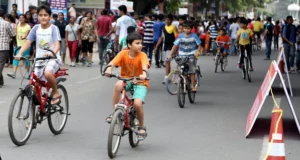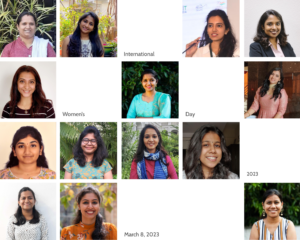
International Women’s Day (March 8) is a global day celebrating women’s social, economic, cultural, and political achievements. The day also marks a call to action for accelerating women’s equality.
For more than a hundred years, International Women’s Day has been a beacon of hope and a call to action for millions of people worldwide. From its humble beginnings in 1911, when over a million people came together to demand women’s rights, IWD has become a global movement that belongs to all of us.
But despite our progress, the fight for gender equality is far from over. As we look to 2023, women still face daunting challenges simply stepping outside their homes. The obstacles can seem insurmountable as women still don’t find equal access to opportunities because of difficulties in commuting and lack of safety.
So how can we make our public spaces better? What works for women and what doesn’t? These are the questions we’re asking ourselves today, and we’re starting by listening to the experiences of the women on our team.
These women are part of the lucky 47% of urban women who are able to venture out into public spaces without fear or hesitation. We’ve asked them to share their stories and their experiences so that we can learn from them and make our work better.
Join us in this conversation as we explore what works and doesn’t for women in public spaces. Let’s work together to create a world where women can thrive, reach their full potential, and feel safe and secure every step of the way.
Favourite memory from an urban space (anywhere in the world)
We asked about a favourite memory and the aspects of the space that shaped their experience to be memorable.
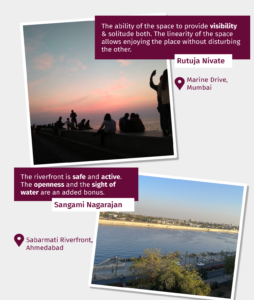
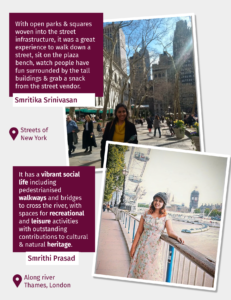
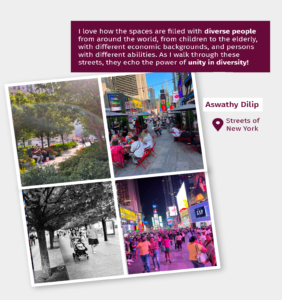
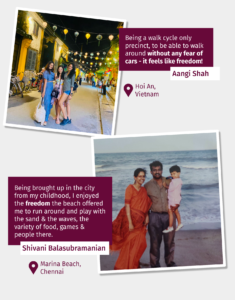
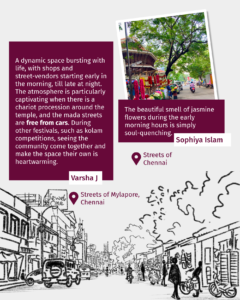
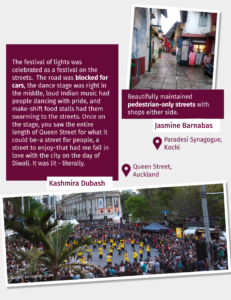
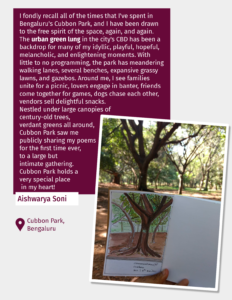
Based on the responses we received:
Eyes on the street are crucial for enhancing experiences in urban spaces as they promote safety and community engagement.
An active street edge with family-friendly activities can attract diverse people and encourage natural surveillance, reducing crime rates and people feeling more secure in their surroundings.
Well-lit environments discourage undesirable activities, further enhancing the sense of personal safety.
By prioritising pedestrians, streets can promote social interaction among residents and visitors, leading to a stronger sense of community and reducing the risk of road crashes.
Car-free streets are also an effective way to enhance the safety and freedom of urban spaces.
Water bodies with active edges have so much potential as urban spaces that they can offer openness and visibility while encouraging ownership through interaction with these water features.
Favourite mode of transport
We asked about the most preferred mode of transport they take and why!
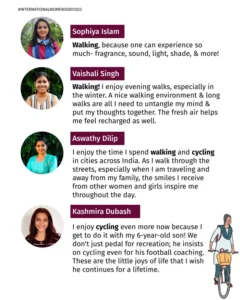
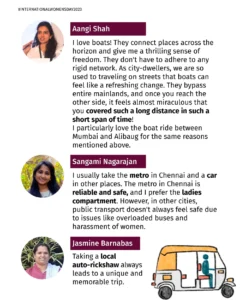

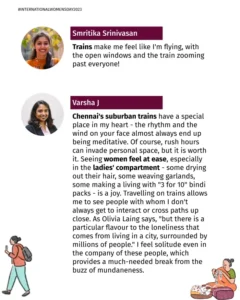
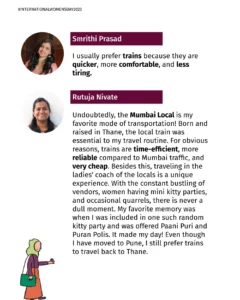
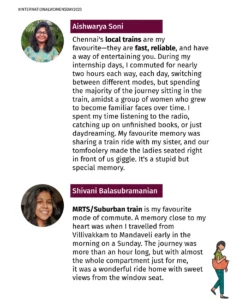
Based on the responses we received:
Trains seemed to be a popular choice and we wondered why that could be! Some features make it tick all the right boxes such as
Adequate lighting: Being well-lit vehicles and stations can help women feel more secure and aware of their surroundings at all times.
Reliable and rapid: With frequent, on-time service with dedicated rapid transit routes, they are quick and reliable.
Clear signage: Clear maps and directions can boost women’s confidence in navigating the public transportation system and decrease the chance of getting lost or stranded. Train stations are usually easier to spot than bus stops, which often suffer from inadequate signage and infrastructure that cause buses to not stop at their designated stops.
Accessible facilities: Train stations are equipped with accessible restrooms and waiting areas that make them convenient and comfortable for women. Having well-maintained and accessible facilities near stops for other modes of public transportation can also increase women’s comfort and sense of security while using these services.
Gender-sensitive design: One big plus in trains, when compared to other public transport systems, are the separate seating areas or women-only carriages, which can provide an added layer of security and comfort.
Are these enough? What more do we need?
Encouraging respectful behaviour towards women by drivers, staff, and other passengers can help create a safer and more welcoming environment. The capacity building of passenger-facing staff in this aspect can help develop an inclusive experience for all users, including women.
As the commissioner of the city…
We asked for a crazy/innovative idea for a technology that could enhance women’s experiences in public spaces or transportation but with a twist.
A solution that aligns with the theme of this International Women’s Day: “DigitALL: Innovation and technology for gender equality”. Here are some quirky and insightful answers!
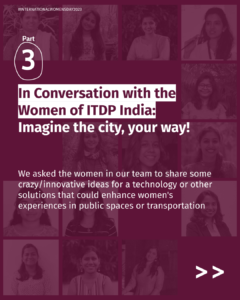

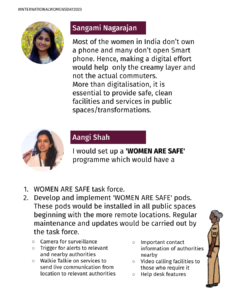
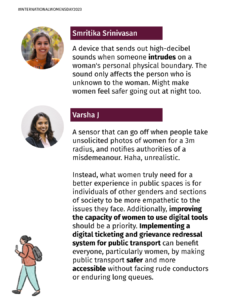
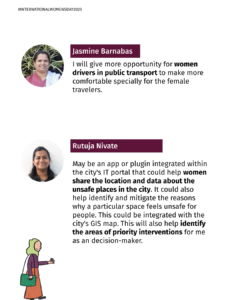
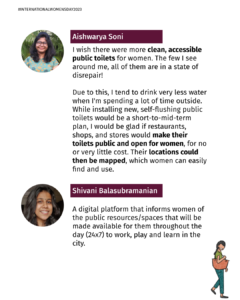
Based on the responses we received:
The solutions provide insight into the challenges that women often encounter, particularly in urban areas. They make it clear that addressing these challenges go beyond just digital interventions but also involves utilising digital innovations as tools to tackle some of these issues.
Access: While solutions can be digital, even accessing them can be a challenge due to various societal pressures that lead to women discontinuing basic education. Through awareness and education, women can attain the literacy they need for equal access.
Basic facilities: Providing basic facilities, such as restrooms, changing rooms, and access to sanitary products, is essential to help women maintain their health and hygiene without having to risk harassment by using unsafe or unsanitary areas.
Safety: Identifying problem areas in urban spaces with hostile environments with lack of insufficient light, with poor visibility and remedying that by installing bright, even lighting in public areas, designing safer spaces with clear sightlines, and pathways that are easily navigable can make women feel safer and reduce risk of harassment when walking around at night.
Enforcement: Patrolling problem spots frequently and making channels easy to access for women to reach out for help can improve women’s sense of safety and lower the risk from perpetrators. Training law enforcement officers on how to respond to incidents of violence and harassment against women can help to ensure that they are equipped to handle these situations in a sensitive and effective manner.
Empowerment: By having more women in the workforce, the representation encourages women to speak out more about their issues, be confident in asserting their rights, and stand up against harassment or violence. This also leads to more inclusive decision-making that can improve their safety.
In conclusion, International Women’s Day reminds us of the importance of empowering women and promoting gender equality in all spheres of life. Women’s participation and representation in decision-making processes concerning urban development and public transport are crucial for creating cities that cater to the needs of not just women, but all individuals, regardless of gender. Gender-sensitive policies and practices ensure that women can access opportunities, services, and spaces that are safe, inclusive, and accessible. As we celebrate Women’s History Month, let us pledge to continue advocating for gender equality and creating a world where women can thrive and reach their full potential. Together, we can build a brighter and more equitable future for all.
Written by Varsha Jeyapandi Edited by Aishwarya Soni
Recent Blogs


Lending a voice to Indian women: ITDP India celebrates women experts in transport
